| Home | Nature Weekly Index |
16 February 2014 | Leaf Beetle | Cheilocostus speciosus (Crepe Ginger) | Ant |
So far, I have shared 2 beetles and their host plants over the last 2 weeks. Here is the third one, an orange beetle (Lema quadripunctata) that is affiliated with Cheilocostus speciosus (Crepe Ginger), a flowering plant formerly known as Costus speciosus. It has large prominent white flowers that sit on maroon bracts. The feeding style of the beetle created multiple elongated holes on the leaves. The beetle is not widespread but confined to certain locations. The park that I frequented happens to be one of these locations which allowed me the convenient to observe the activity of this beetle on a regular basis.
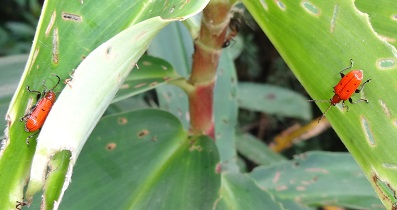
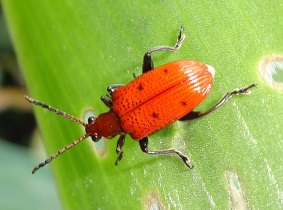
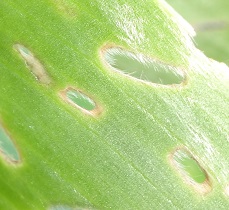
I have an interest on ants since I was a kid although for different reasons between then and now. Cheilocostus speciosus offers an
ideal platform to observe ants. 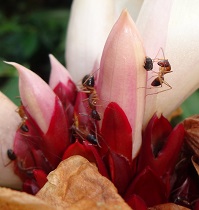
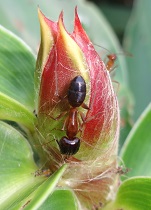 Ants like to gather on the
maroon bracts when the flowers are blooming or in the bud stage. The bracts seem to produce some stuff that attract the ants and
keep them motionless most of the time. As the bracts are usually at eye level, I can stare at the ants for as long as I wish
without feeling too much of discomfort compared to bending my back to observe ants on the ground. The only downside is that taking
picture of the ants is not ideal on the maroon bracts as maroon colour merges with the colour of most ants.
Ants like to gather on the
maroon bracts when the flowers are blooming or in the bud stage. The bracts seem to produce some stuff that attract the ants and
keep them motionless most of the time. As the bracts are usually at eye level, I can stare at the ants for as long as I wish
without feeling too much of discomfort compared to bending my back to observe ants on the ground. The only downside is that taking
picture of the ants is not ideal on the maroon bracts as maroon colour merges with the colour of most ants.
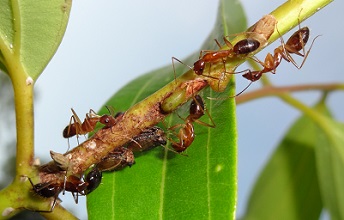
Only one type of ant will congregate on each flower head. However, the type of ants present on the same bracts change over time. This particular ant showcase here is the Giant Honey Ant (Camponotus irritans). It is not exactly "giant" but belongs to the group of ants with larger body size, at least twice the length of the more commonly seen Yellow Crazy Ant (Anoplolepis gracilipes). The ant has at least 2 sub-types in term of appearance, one with large head and one with a smaller head. It does not commonly roam in open ground but prefer to stay above ground level on plants. Like most ants, they are good friends to the treehoppers. The ant and treehopper contingent in the picture were found on a young Wild Cinnamon tree (Cinnamomum iners).